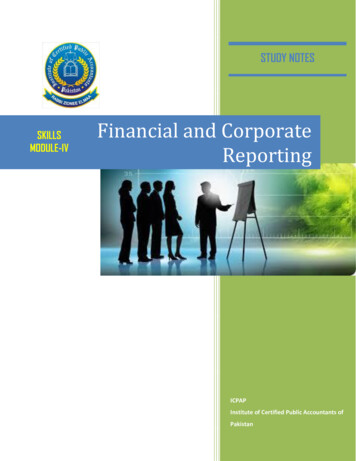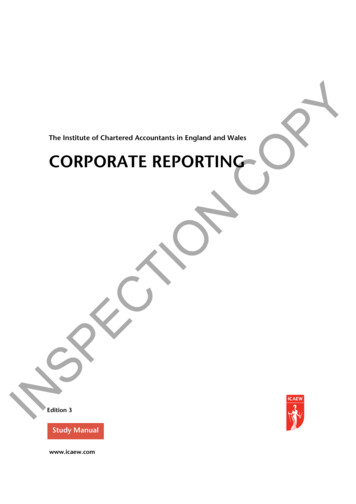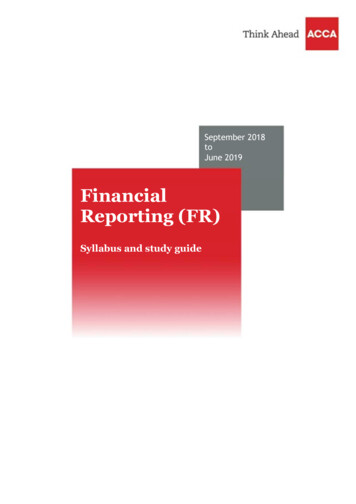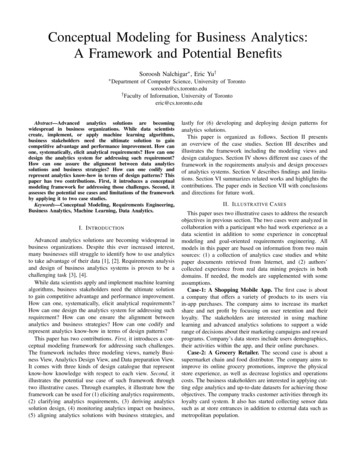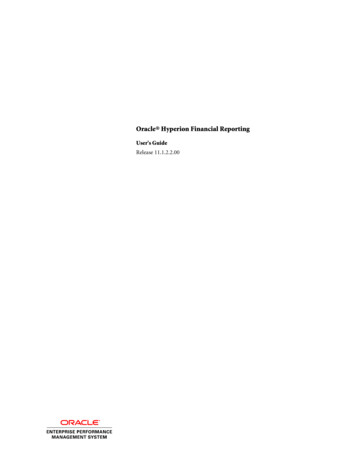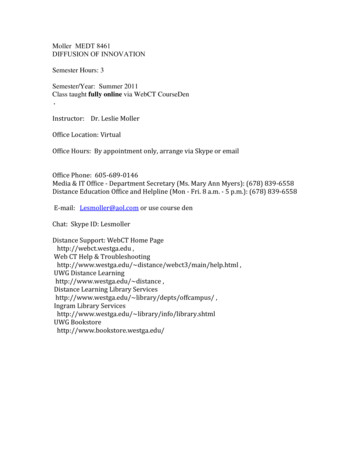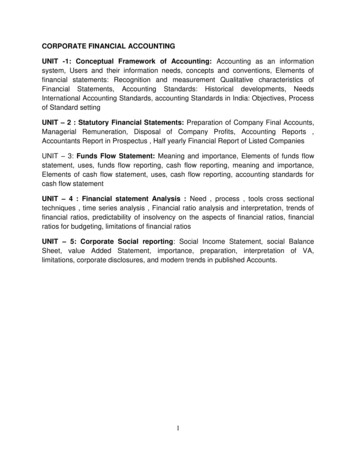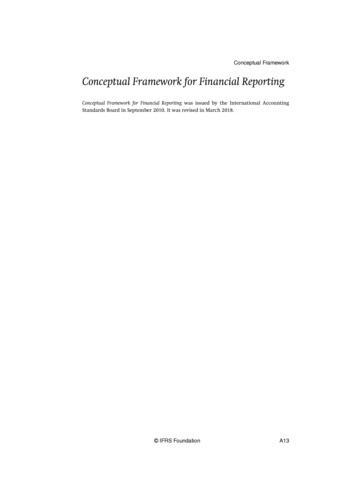
Transcription
Conceptual FrameworkConceptual Framework for Financial ReportingConceptual Framework for Financial Reporting was issued by the International AccountingStandards Board in September 2010. It was revised in March 2018. IFRS FoundationA13
Conceptual FrameworkCONTENTSfrom paragraphSTATUS AND PURPOSE OF THE CONCEPTUAL FRAMEWORKSP1.1CHAPTER 1—THE OBJECTIVE OF GENERAL PURPOSEFINANCIAL REPORTINGINTRODUCTION1.1OBJECTIVE, USEFULNESS AND LIMITATIONS OF GENERAL PURPOSEFINANCIAL REPORTING1.2INFORMATION ABOUT A REPORTING ENTITY’S ECONOMIC RESOURCES,CLAIMS AGAINST THE ENTITY AND CHANGES IN RESOURCES ANDCLAIMS1.12Economic resources and claims1.13Changes in economic resources and claims1.15Financial performance reflected by accrual accounting1.17Financial performance reflected by past cash flows1.20Changes in economic resources and claims not resulting from financialperformance1.21INFORMATION ABOUT USE OF THE ENTITY’S ECONOMIC RESOURCES1.22CHAPTER 2—QUALITATIVE CHARACTERISTICS OF USEFULFINANCIAL INFORMATIONINTRODUCTION2.1QUALITATIVE CHARACTERISTICS OF USEFUL FINANCIAL INFORMATION2.4Fundamental qualitative characteristics2.5Enhancing qualitative characteristics2.23THE COST CONSTRAINT ON USEFUL FINANCIAL REPORTING2.39CHAPTER 3—FINANCIAL STATEMENTS AND THEREPORTING ENTITYFINANCIAL STATEMENTS3.1Objective and scope of financial statements3.2Reporting period3.4Perspective adopted in financial statements3.8Going concern assumption3.9THE REPORTING ENTITY3.10Consolidated and unconsolidated financial statements3.15CHAPTER 4—THE ELEMENTS OF FINANCIAL STATEMENTSINTRODUCTION4.1DEFINITION OF AN ASSET4.3Right4.6Potential to produce economic benefits4.14continued.A14 IFRS Foundation
Conceptual Framework.continuedControl4.19DEFINITION OF A LIABILITY4.26Obligation4.28Transfer of an economic resource4.36Present obligation as a result of past events4.42ASSETS AND LIABILITIES4.48Unit of account4.48Executory contracts4.56Substance of contractual rights and contractual obligations4.59DEFINITION OF EQUITY4.63DEFINITIONS OF INCOME AND EXPENSES4.68CHAPTER 5—RECOGNITION AND DERECOGNITIONTHE RECOGNITION PROCESS5.1RECOGNITION CRITERIA5.6Relevance5.12Faithful representation5.18DERECOGNITION5.26CHAPTER 6—MEASUREMENTINTRODUCTION6.1MEASUREMENT BASES6.4Historical cost6.4Current value6.10INFORMATION PROVIDED BY PARTICULAR MEASUREMENT BASES6.23Historical cost6.24Current value6.32FACTORS TO CONSIDER WHEN SELECTING A MEASUREMENT BASIS6.43Relevance6.49Faithful representation6.58Enhancing qualitative characteristics and the cost constraint6.63Factors specific to initial measurement6.77More than one measurement basis6.83MEASUREMENT OF EQUITY6.87CASH-FLOW-BASED MEASUREMENT TECHNIQUES6.91CHAPTER 7—PRESENTATION AND DISCLOSUREPRESENTATION AND DISCLOSURE AS COMMUNICATION TOOLS7.1PRESENTATION AND DISCLOSURE OBJECTIVES AND PRINCIPLES7.4CLASSIFICATION7.7continued. IFRS FoundationA15
Conceptual Framework.continuedClassification of assets and liabilities7.9Classification of equity7.12Classification of income and expenses7.14AGGREGATION7.20CHAPTER 8—CONCEPTS OF CAPITAL AND CAPITALMAINTENANCECONCEPTS OF CAPITAL8.1CONCEPTS OF CAPITAL MAINTENANCE AND THE DETERMINATION OFPROFIT8.3CAPITAL MAINTENANCE ADJUSTMENTSAPPENDIX—DEFINED TERMSAPPROVAL BY THE BOARD OF THE CONCEPTUAL FRAMEWORK FORFINANCIAL REPORTING ISSUED IN MARCH 2018FOR THE BASIS FOR CONCLUSIONS, SEE PART C OF THIS EDITIONBASIS FOR CONCLUSIONSA16 IFRS Foundation8.10
Conceptual FrameworkSTATUS AND PURPOSE OF THE CONCEPTUAL FRAMEWORKSP1.1The Conceptual Framework for Financial Reporting (Conceptual Framework) describesthe objective of, and the concepts for, general purpose financial reporting. Thepurpose of the Conceptual Framework is to:(a)assist the International Accounting Standards Board (Board) to developIFRS Standards (Standards) that are based on consistent concepts;(b)assist preparers to develop consistent accounting policies when noStandard applies to a particular transaction or other event, or when aStandard allows a choice of accounting policy; and(c)assist all parties to understand and interpret the Standards.SP1.2The Conceptual Framework is not a Standard. Nothing in the ConceptualFramework overrides any Standard or any requirement in a Standard.SP1.3To meet the objective of general purpose financial reporting, the Board maysometimes specify requirements that depart from aspects of the ConceptualFramework. If the Board does so, it will explain the departure in the Basis forConclusions on that Standard.SP1.4The Conceptual Framework may be revised from time to time on the basis of theBoard’s experience of working with it. Revisions of the ConceptualFramework will not automatically lead to changes to the Standards. Anydecision to amend a Standard would require the Board to go through its dueprocess for adding a project to its agenda and developing an amendment tothat Standard.SP1.5The Conceptual Framework contributes to the stated mission of the IFRSFoundation and of the Board, which is part of the IFRS Foundation. Thatmission is to develop Standards that bring transparency, accountability andefficiency to financial markets around the world. The Board’s work serves thepublic interest by fostering trust, growth and long-term financial stability inthe global economy. The Conceptual Framework provides the foundation forStandards that:(a)contribute to transparency by enhancing the internationalcomparability and quality of financial information, enabling investorsand other market participants to make informed economic decisions.(b)strengthen accountability by reducing the information gap betweenthe providers of capital and the people to whom they have entrustedtheir money. Standards based on the Conceptual Framework provideinformation needed to hold management to account. As a source ofglobally comparable information, those Standards are also of vitalimportance to regulators around the world.(c)contribute to economic efficiency by helping investors to identifyopportunities and risks across the world, thus improving capitalallocation. For businesses, the use of a single, trusted accountinglanguage derived from Standards based on the Conceptual Frameworklowers the cost of capital and reduces international reporting costs. IFRS FoundationA17
Conceptual FrameworkCONTENTSfrom paragraphCHAPTER 1—THE OBJECTIVE OF GENERAL PURPOSEFINANCIAL REPORTINGINTRODUCTION1.1OBJECTIVE, USEFULNESS AND LIMITATIONS OF GENERAL PURPOSEFINANCIAL REPORTING1.2INFORMATION ABOUT A REPORTING ENTITY’S ECONOMIC RESOURCES,CLAIMS AGAINST THE ENTITY AND CHANGES IN RESOURCES ANDCLAIMS1.12Economic resources and claims1.13Changes in economic resources and claims1.15Financial performance reflected by accrual accounting1.17Financial performance reflected by past cash flows1.20Changes in economic resources and claims not resulting from financialperformance1.21INFORMATION ABOUT USE OF THE ENTITY’S ECONOMIC RESOURCES1.22A18 IFRS Foundation
Conceptual FrameworkIntroduction1.1The objective of general purpose financial reporting forms the foundation ofthe Conceptual Framework. Other aspects of the Conceptual Framework—thequalitative characteristics of, and the cost constraint on, useful financialinformation, a reporting entity concept, elements of financial statements,recognition and derecognition, measurement, presentation and disclosure —flow logically from the objective.Objective, usefulness and limitations of general purpose financialreporting1.2The objective of general purpose financial reporting1 is to provide financialinformation about the reporting entity that is useful to existing and potentialinvestors, lenders and other creditors in making decisions relating toproviding resources to the entity.2 Those decisions involve decisions about:(a)buying, selling or holding equity and debt instruments;(b)providing or settling loans and other forms of credit; or(c)exercising rights to vote on, or otherwise influence, management’sactions that affect the use of the entity’s economic resources.1.3The decisions described in paragraph 1.2 depend on the returns that existingand potential investors, lenders and other creditors expect, for example,dividends, principal and interest payments or market price increases.Investors’, lenders’ and other creditors’ expectations about returns depend ontheir assessment of the amount, timing and uncertainty of (the prospects for)future net cash inflows to the entity and on their assessment ofmanagement’s stewardship of the entity’s economic resources. Existing andpotential investors, lenders and other creditors need information to help themmake those assessments.1.4To make the assessments described in paragraph 1.3, existing and potentialinvestors, lenders and other creditors need information about:123(a)the economic resources of the entity, claims against the entity andchanges in those resources and claims (see paragraphs 1.12–1.21); and(b)how efficiently and effectively the entity’s management and governingboard3 have discharged their responsibilities to use the entity’seconomic resources (see paragraphs 1.22–1.23).Throughout the Conceptual Framework, the terms ‘financial reports’ and ‘financial reporting’ referto general purpose financial reports and general purpose financial reporting unless specificallyindicated otherwise.Throughout the Conceptual Framework, the term ‘entity’ refers to the reporting entity unlessspecifically indicated otherwise.Throughout the Conceptual Framework, the term ‘management’ refers to management and thegoverning board of an entity unless specifically indicated otherwise. IFRS FoundationA19
Conceptual Framework1.5Many existing and potential investors, lenders and other creditors cannotrequire reporting entities to provide information directly to them and mustrely on general purpose financial reports for much of the financialinformation they need. Consequently, they are the primary users to whomgeneral purpose financial reports are directed.41.6However, general purpose financial reports do not and cannot provide all ofthe information that existing and potential investors, lenders and othercreditors need. Those users need to consider pertinent information from othersources, for example, general economic conditions and expectations, politicalevents and political climate, and industry and company outlooks.1.7General purpose financial reports are not designed to show the value of areporting entity; but they provide information to help existing and potentialinvestors, lenders and other creditors to estimate the value of the reportingentity.1.8Individual primary users have different, and possibly conflicting, informationneeds and desires. The Board, in developing Standards, will seek to provide theinformation set that will meet the needs of the maximum number of primaryusers. However, focusing on common information needs does not prevent thereporting entity from including additional information that is most useful to aparticular subset of primary users.1.9The management of a reporting entity is also interested in financialinformation about the entity. However, management need not rely on generalpurpose financial reports because it is able to obtain the financial informationit needs internally.1.10Other parties, such as regulators and members of the public other thaninvestors, lenders and other creditors, may also find general purpose financialreports useful. However, those reports are not primarily directed to theseother groups.1.11To a large extent, financial reports are based on estimates, judgements andmodels rather than exact depictions. The Conceptual Framework establishes theconcepts that underlie those estimates, judgements and models. The conceptsare the goal towards which the Board and preparers of financial reports strive.As with most goals, the Conceptual Framework’s vision of ideal financialreporting is unlikely to be achieved in full, at least not in the short term,because it takes time to understand, accept and implement new ways ofanalysing transactions and other events. Nevertheless, establishing a goaltowards which to strive is essential if financial reporting is to evolve so as toimprove its usefulness.4Throughout the Conceptual Framework, the terms ‘primary users’ and ‘users’ refer to those existingand potential investors, lenders and other creditors who must rely on general purpose financialreports for much of the financial information they need.A20 IFRS Foundation
Conceptual FrameworkInformation about a reporting entity’s economic resources, claimsagainst the entity and changes in resources and claims1.12General purpose financial reports provide information about the financialposition of a reporting entity, which is information about the entity’seconomic resources and the claims against the reporting entity. Financialreports also provide information about the effects of transactions and otherevents that change a reporting entity’s economic resources and claims. Bothtypes of information provide useful input for decisions relating to providingresources to an entity.Economic resources and claims1.13Information about the nature and amounts of a reporting entity’s economicresources and claims can help users to identify the reporting entity’s financialstrengths and weaknesses. That information can help users to assess thereporting entity’s liquidity and solvency, its needs for additional financing andhow successful it is likely to be in obtaining that financing. That informationcan also help users to assess management’s stewardship of the entity’seconomic resources. Information about priorities and payment requirementsof existing claims helps users to predict how future cash flows will bedistributed among those with a claim against the reporting entity.1.14Different types of economic resources affect a user’s assessment of thereporting entity’s prospects for future cash flows differently. Some futurecash flows result directly from existing economic resources, such as accountsreceivable. Other cash flows result from using several resources incombination to produce and market goods or services to customers. Althoughthose cash flows cannot be identified with individual economic resources (orclaims), users of financial reports need to know the nature and amount of theresources available for use in a reporting entity’s operations.Changes in economic resources and claims1.15Changes in a reporting entity’s economic resources and claims result fromthat entity’s financial performance (see paragraphs 1.17–1.20) and from otherevents or transactions such as issuing debt or equity instruments (seeparagraph 1.21). To properly assess both the prospects for future net cashinflows to the reporting entity and management’s stewardship of the entity’seconomic resources, users need to be able to identify those two types ofchanges.1.16Information about a reporting entity’s financial performance helps users tounderstand the return that the entity has produced on its economic resources.Information about the return the entity has produced can help users to assessmanagement’s stewardship of the entity’s economic resources. Informationabout the variability and components of that return is also important,especially in assessing the uncertainty of future cash flows. Information abouta reporting entity’s past financial performance and how its managementdischarged its stewardship responsibilities is usually helpful in predicting theentity’s future returns on its economic resources. IFRS FoundationA21
Conceptual FrameworkFinancial performance reflected by accrual accounting1.17Accrual accounting depicts the effects of transactions and other events andcircumstances on a reporting entity’s economic resources and claims in theperiods in which those effects occur, even if the resulting cash receipts andpayments occur in a different period. This is important because informationabout a reporting entity’s economic resources and claims and changes in itseconomic resources and claims during a period provides a better basis forassessing the entity’s past and future performance than information solelyabout cash receipts and payments during that period.1.18Information about a reporting entity’s financial performance during a period,reflected by changes in its economic resources and claims other than byobtaining additional resources directly from investors and creditors (seeparagraph 1.21), is useful in assessing the entity’s past and future ability togenerate net cash inflows. That information indicates the extent to which thereporting entity has increased its available economic resources, and thus itscapacity for generating net cash inflows through its operations rather than byobtaining additional resources directly from investors and creditors.Information about a reporting entity’s financial performance during a periodcan also help users to assess management’s stewardship of the entity’seconomic resources.1.19Information about a reporting entity’s financial performance during a periodmay also indicate the extent to which events such as changes in market pricesor interest rates have increased or decreased the entity’s economic resourcesand claims, thereby affecting the entity’s ability to generate net cash inflows.Financial performance reflected by past cash flows1.20Information about a reporting entity’s cash flows during a period also helpsusers to assess the entity’s ability to generate future net cash inflows and toassess management’s stewardship of the entity’s economic resources. Thatinformation indicates how the reporting entity obtains and spends cash,including information about its borrowing and repayment of debt, cashdividends or other cash distributions to investors, and other factors that mayaffect the entity’s liquidity or solvency. Information about cash flows helpsusers understand a reporting entity’s operations, evaluate its financing andinvesting activities, assess its liquidity or solvency and interpret otherinformation about financial performance.Changes in economic resources and claims not resultingfrom financial performance1.21A22A reporting entity’s economic resources and claims may also change forreasons other than financial performance, such as issuing debt or equityinstruments. Information about this type of change is necessary to give users acomplete understanding of why the reporting entity’s economic resources andclaims changed and the implications of those changes for its future financialperformance. IFRS Foundation
Conceptual FrameworkInformation about use of the entity’s economic resources1.22Information about how efficiently and effectively the reporting entity’smanagement has discharged its responsibilities to use the entity’s economicresources helps users to assess management’s stewardship of those resources.Such information is also useful for predicting how efficiently and effectivelymanagement will use the entity’s economic resources in future periods.Hence, it can be useful for assessing the entity’s prospects for future net cashinflows.1.23Examples of management’s responsibilities to use the entity’s economicresources include protecting those resources from unfavourable effects ofeconomic factors, such as price and technological changes, and ensuring thatthe entity complies with applicable laws, regulations and contractualprovisions. IFRS FoundationA23
Conceptual FrameworkCONTENTSfrom paragraphCHAPTER 2—QUALITATIVE CHARACTERISTICS OF USEFULFINANCIAL INFORMATIONINTRODUCTION2.1QUALITATIVE CHARACTERISTICS OF USEFUL FINANCIAL INFORMATION2.4Fundamental qualitative ful representation2.12Applying the fundamental qualitative characteristics2.20Enhancing qualitative .30Timeliness2.33Understandability2.34Applying the enhancing qualitative characteristics2.37THE COST CONSTRAINT ON USEFUL FINANCIAL REPORTINGA24 IFRS Foundation2.39
Conceptual FrameworkIntroduction2.1The qualitative characteristics of useful financial information discussed in thischapter identify the types of information that are likely to be most useful tothe existing and potential investors, lenders and other creditors for makingdecisions about the reporting entity on the basis of information in its financialreport (financial information).2.2Financial reports provide information about the reporting entity’s economicresources, claims against the reporting entity and the effects of transactionsand other events and conditions that change those resources and claims. (Thisinformation is referred to in the Conceptual Framework as information about theeconomic phenomena.) Some financial reports also include explanatorymaterial about management’s expectations and strategies for the reportingentity, and other types of forward-looking information.2.3The qualitative characteristics of useful financial information5 apply tofinancial information provided in financial statements, as well as to financialinformation provided in other ways. Cost, which is a pervasive constraint onthe reporting entity’s ability to provide useful financial information, appliessimilarly. However, the considerations in applying the qualitativecharacteristics and the cost constraint may be different for different types ofinformation. For example, applying them to forward-looking information maybe different from applying them to information about existing economicresources and claims and to changes in those resources and claims.Qualitative characteristics of useful financial information2.4If financial information is to be useful, it must be relevant and faithfullyrepresent what it purports to represent. The usefulness of financialinformation is enhanced if it is comparable, verifiable, timely andunderstandable.Fundamental qualitative characteristics2.5The fundamental qualitative characteristics are relevance and faithfulrepresentation.Relevance2.6Relevant financial information is capable of making a difference in thedecisions made by users. Information may be capable of making a differencein a decision even if some users choose not to take advantage of it or arealready aware of it from other sources.2.7Financial information is capable of making a difference in decisions if it haspredictive value, confirmatory value or both.5Throughout the Conceptual Framework, the terms ‘qualitative characteristics’ and ‘cost constraint’refer to the qualitative characteristics of, and the cost constraint on, useful financialinformation. IFRS FoundationA25
Conceptual Framework2.8Financial information has predictive value if it can be used as an input toprocesses employed by users to predict future outcomes. Financialinformation need not be a prediction or forecast to have predictive value.Financial information with predictive value is employed by users in makingtheir own predictions.2.9Financial information has confirmatory value if it provides feedback about(confirms or changes) previous evaluations.2.10The predictive value and confirmatory value of financial information areinterrelated. Information that has predictive value often also has confirmatoryvalue. For example, revenue information for the current year, which can beused as the basis for predicting revenues in future years, can also be comparedwith revenue predictions for the current year that were made in past years.The results of those comparisons can help a user to correct and improve theprocesses that were used to make those previous predictions.Materiality2.11Information is material if omitting, misstating or obscuring it couldreasonably be expected to influence decisions that the primary users ofgeneral purpose financial reports (see paragraph 1.5) make on the basis ofthose reports, which provide financial information about a specific reportingentity. In other words, materiality is an entity-specific aspect of relevancebased on the nature or magnitude, or both, of the items to which theinformation relates in the context of an individual entity’s financial report.Consequently, the Board cannot specify a uniform quantitative threshold formateriality or predetermine what could be material in a particular situation.Faithful representation2.12Financial reports represent economic phenomena in words and numbers. Tobe useful, financial information must not only represent relevant phenomena,but it must also faithfully represent the substance of the phenomena that itpurports to represent. In many circumstances, the substance of an economicphenomenon and its legal form are the same. If they are not the same,providing information only about the legal form would not faithfullyrepresent the economic phenomenon (see paragraphs 4.59–4.62).2.13To be a perfectly faithful representation, a depiction would have threecharacteristics. It would be complete, neutral and free from error. Of course,perfection is seldom, if ever, achievable. The Board’s objective is to maximisethose qualities to the extent possible.2.14A complete depiction includes all information necessary for a user tounderstand the phenomenon being depicted, including all necessarydescriptions and explanations. For example, a complete depiction of a group ofassets would include, at a minimum, a description of the nature of the assetsin the group, a numerical depiction of all of the assets in the group, and adescription of what the numerical depiction represents (for example,historical cost or fair value). For some items, a complete depiction may alsoentail explanations of significant facts about the quality and nature of theA26 IFRS Foundation
Conceptual Frameworkitems, factors and circumstances that might affect their quality and nature,and the process used to determine the numerical depiction.2.15A neutral depiction is without bias in the selection or presentation of financialinformation. A neutral depiction is not slanted, weighted, emphasised,de-emphasised or otherwise manipulated to increase the probability thatfinancial information will be received favourably or unfavourably by users.Neutral information does not mean information with no purpose or noinfluence on behaviour. On the contrary, relevant financial information is, bydefinition, capable of making a difference in users’ decisions.2.16Neutrality is supported by the exercise of prudence. Prudence is the exerciseof caution when making judgements under conditions of uncertainty. Theexercise of prudence means that assets and income are not overstated andliabilities and expenses are not understated.6 Equally, the exercise of prudencedoes not allow for the understatement of assets or income or theoverstatement of liabilities or expenses. Such misstatements can lead to theoverstatement or understatement of income or expenses in future periods.2.17The exercise of prudence does not imply a need for asymmetry, for example, asystematic need for more persuasive evidence to support the recognition ofassets or income than the recognition of liabilities or expenses. Suchasymmetry is not a qualitative characteristic of useful financial information.Nevertheless, particular Standards may contain asymmetric requirements ifthis is a consequence of decisions intended to select the most relevantinformation that faithfully represents what it purports to represent.2.18Faithful representation does not mean accurate in all respects. Free from errormeans there are no errors or omissions in the description of the phenomenon,and the process used to produce the reported information has been selectedand applied with no errors in the process. In this context, free from error doesnot mean perfectly accurate in all respects. For example, an estimate of anunobservable price or value cannot be determined to be accurate orinaccurate. However, a representation of that estimate can be faithful if theamount is described clearly and accurately as being an estimate, the natureand limitations of the estimating process are explained, and no errors havebeen made in selecting and applying an appropriate process for developing theestimate.2.19When monetary amounts in financial reports cannot be observed directly andmust instead be estimated, measurement uncertainty arises. The use ofreasonable estimates is an essential part of the preparation of financialinformation and does not undermine the usefulness of the information if theestimates are clearly and accurately described and explained. Even a high levelof measurement uncertainty does not necessarily prevent such an estimatefrom providing useful information (see paragraph 2.22).6Assets, liabilities, income and expenses are defined in Table 4.1. They are the elements offinancial statements. IFRS FoundationA27
Conceptual FrameworkApplying the fundamental qualitative characteristics2.20Information must both be relevant and provide a faithful representation ofwhat it purports to represent if it is to be useful. Neither a faithfulrepresentation of an irrelevant phenomenon nor an unfaithful representationof a relevant phenomenon helps users make good decisions.2.21The most efficient and effective process for applying the fundamentalqualitative characteristics would usually be as follows (subject to the effects ofenhancing characteristics and the cost constraint, which are not considered inthis example). First, identify an economic phenomenon, information aboutwhich is capable of being useful to users of the reporting entity’s financialinformation. Second, identify the type of information about that phenomenonthat would be most relevant. Third, determine whether that information isavailable and whether it can provide a faithful representation of the economicphenomenon. If so, the process of satisfying the fundamental qualitativecharacteristics ends at that point. If not, the process is repeated with the nextmost relevant type of information.2.22In some cases, a trade-off between the fundamental qualitative characteristicsmay need to be made in order t
The objective of general purpose financial reporting forms the foundation of the . Conceptual Framework. Other aspects of the . Conceptual Framework —the qualitative characteristics of, and the cost constraint on, useful financial information, a reporting entity co
